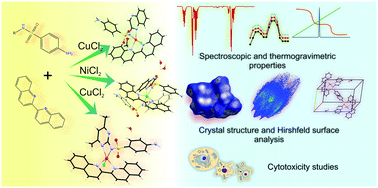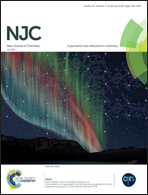Crystal structure, Hirshfeld surface analysis, spectroscopic and biological studies on sulfamethazine and sulfaquinoxaline ternary complexes with 2,2′-biquinoline†
Abstract
Three ternary complexes of sulfaquinoxaline (SQO – 4-amino-N-2-quinoxalinylbenzenesulfonamide) or sulfamethazine (SMT – 4-amino-N-(4,6-dimethylpyrimidin-2-yl)-benzenesulfonamide) with Cu(II) or Ni(II) and 2,2′-biquinoline (BQ) as an auxiliary ligand have been studied. Their structures have been determined by single-crystal X-ray crystallography as Ni(SQO)2(BQ)·2H2O (I), Cu(SQO)(BQ)Cl·CH3OH (II) and Cu(SMT)(BQ)Cl (III). Compounds I and II crystallize in the triclinic space group P![[1 with combining macron]](https://www.rsc.org/images/entities/char_0031_0304.gif) while complex III crystallizes in the monoclinic P21/c space group. The crystal lattice of all complexes is stabilized by the presence of diverse intermolecular interactions as verified by Hirshfeld surface analysis. Besides, electronic spectroscopies have also been used to characterize the compounds. The thermal behavior of the complexes was investigated by thermogravimetric and differential thermal analyses. Furthermore, the cytotoxic effect of the compounds has been tested against A549 (lung cancer) and MG-63 (human osteosarcoma) cell lines using the MTT methodology.
while complex III crystallizes in the monoclinic P21/c space group. The crystal lattice of all complexes is stabilized by the presence of diverse intermolecular interactions as verified by Hirshfeld surface analysis. Besides, electronic spectroscopies have also been used to characterize the compounds. The thermal behavior of the complexes was investigated by thermogravimetric and differential thermal analyses. Furthermore, the cytotoxic effect of the compounds has been tested against A549 (lung cancer) and MG-63 (human osteosarcoma) cell lines using the MTT methodology.



 Please wait while we load your content...
Please wait while we load your content...